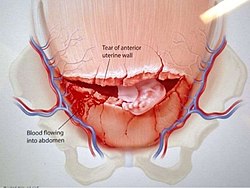Uterine rupture

Editor-In-Chief: Prab R Tumpati, MD
Obesity, Sleep & Internal medicine
Founder, WikiMD Wellnesspedia &
W8MD medical weight loss NYC and sleep center NYC
| Uterine rupture | |
|---|---|

| |
| Synonyms | |
| Pronounce | N/A |
| Specialty | N/A |
| Symptoms | Abnormal fetal heart rate, abdominal pain, vaginal bleeding, hypotension |
| Complications | Fetal distress, hemorrhage, hysterectomy, maternal death |
| Onset | During labor |
| Duration | |
| Types | Complete uterine rupture, incomplete uterine rupture |
| Causes | Previous cesarean section, trauma, induction of labor |
| Risks | Multiple pregnancies, uterine overdistension, prolonged labor |
| Diagnosis | Ultrasound, fetal monitoring, clinical examination |
| Differential diagnosis | Placental abruption, preterm labor, appendicitis |
| Prevention | Trial of labor after cesarean (TOLAC) in appropriate candidates, careful monitoring during labor |
| Treatment | Emergency cesarean section, blood transfusion, surgical repair |
| Medication | |
| Prognosis | Depends on promptness of treatment |
| Frequency | Rare |
| Deaths | |
A serious childbirth complication
Template:Medical condition (new)
Uterine rupture is a serious obstetric complication where the muscular wall of the uterus tears during pregnancy or childbirth. This condition can lead to severe maternal and fetal morbidity and mortality if not promptly diagnosed and managed.
Pathophysiology[edit]
Uterine rupture typically occurs during labor and is often associated with a previous cesarean section scar. The rupture can be complete, involving all layers of the uterine wall, or incomplete, where the peritoneum remains intact. The most common site for rupture is the lower uterine segment.
Risk Factors[edit]
Several factors increase the risk of uterine rupture, including:
- Previous cesarean delivery
- Induction of labor with oxytocin or prostaglandins
- High parity (having given birth multiple times)
- Trauma to the uterus
- Congenital uterine anomalies
Clinical Presentation[edit]
The symptoms of uterine rupture can vary but often include:
- Sudden onset of abdominal pain
- Vaginal bleeding
- Loss of fetal station
- Abnormal fetal heart rate patterns
- Maternal tachycardia and hypotension
Diagnosis[edit]
Diagnosis is primarily clinical, supported by ultrasound findings. In some cases, a sudden change in the fetal heart rate pattern may be the first indication of a rupture.
Management[edit]
Immediate surgical intervention is required to manage uterine rupture. This typically involves an emergency laparotomy and repair of the uterine defect or hysterectomy if repair is not feasible. Rapid delivery of the fetus is crucial to minimize fetal and maternal complications.
Prognosis[edit]
The prognosis depends on the speed of diagnosis and intervention. Prompt surgical management can significantly reduce the risk of severe outcomes for both the mother and the fetus.
Prevention[edit]
Preventive strategies include careful monitoring of labor in women with a history of cesarean delivery and avoiding unnecessary induction of labor. Elective repeat cesarean delivery may be recommended for women at high risk of rupture.
See also[edit]
Ad. Transform your life with W8MD's Budget GLP-1 injections from $75


W8MD offers a medical weight loss program to lose weight in Philadelphia. Our physician-supervised medical weight loss provides:
- Weight loss injections in NYC (generic and brand names):
- Zepbound / Mounjaro, Wegovy / Ozempic, Saxenda
- Most insurances accepted or discounted self-pay rates. We will obtain insurance prior authorizations if needed.
- Generic GLP1 weight loss injections from $75 for the starting dose.
- Also offer prescription weight loss medications including Phentermine, Qsymia, Diethylpropion, Contrave etc.
NYC weight loss doctor appointmentsNYC weight loss doctor appointments
Start your NYC weight loss journey today at our NYC medical weight loss and Philadelphia medical weight loss clinics.
- Call 718-946-5500 to lose weight in NYC or for medical weight loss in Philadelphia 215-676-2334.
- Tags:NYC medical weight loss, Philadelphia lose weight Zepbound NYC, Budget GLP1 weight loss injections, Wegovy Philadelphia, Wegovy NYC, Philadelphia medical weight loss, Brookly weight loss and Wegovy NYC
|
WikiMD's Wellness Encyclopedia |
| Let Food Be Thy Medicine Medicine Thy Food - Hippocrates |
Medical Disclaimer: WikiMD is not a substitute for professional medical advice. The information on WikiMD is provided as an information resource only, may be incorrect, outdated or misleading, and is not to be used or relied on for any diagnostic or treatment purposes. Please consult your health care provider before making any healthcare decisions or for guidance about a specific medical condition. WikiMD expressly disclaims responsibility, and shall have no liability, for any damages, loss, injury, or liability whatsoever suffered as a result of your reliance on the information contained in this site. By visiting this site you agree to the foregoing terms and conditions, which may from time to time be changed or supplemented by WikiMD. If you do not agree to the foregoing terms and conditions, you should not enter or use this site. See full disclaimer.
Credits:Most images are courtesy of Wikimedia commons, and templates, categories Wikipedia, licensed under CC BY SA or similar.
Translate this page: - East Asian
中文,
日本,
한국어,
South Asian
हिन्दी,
தமிழ்,
తెలుగు,
Urdu,
ಕನ್ನಡ,
Southeast Asian
Indonesian,
Vietnamese,
Thai,
မြန်မာဘာသာ,
বাংলা
European
español,
Deutsch,
français,
Greek,
português do Brasil,
polski,
română,
русский,
Nederlands,
norsk,
svenska,
suomi,
Italian
Middle Eastern & African
عربى,
Turkish,
Persian,
Hebrew,
Afrikaans,
isiZulu,
Kiswahili,
Other
Bulgarian,
Hungarian,
Czech,
Swedish,
മലയാളം,
मराठी,
ਪੰਜਾਬੀ,
ગુજરાતી,
Portuguese,
Ukrainian